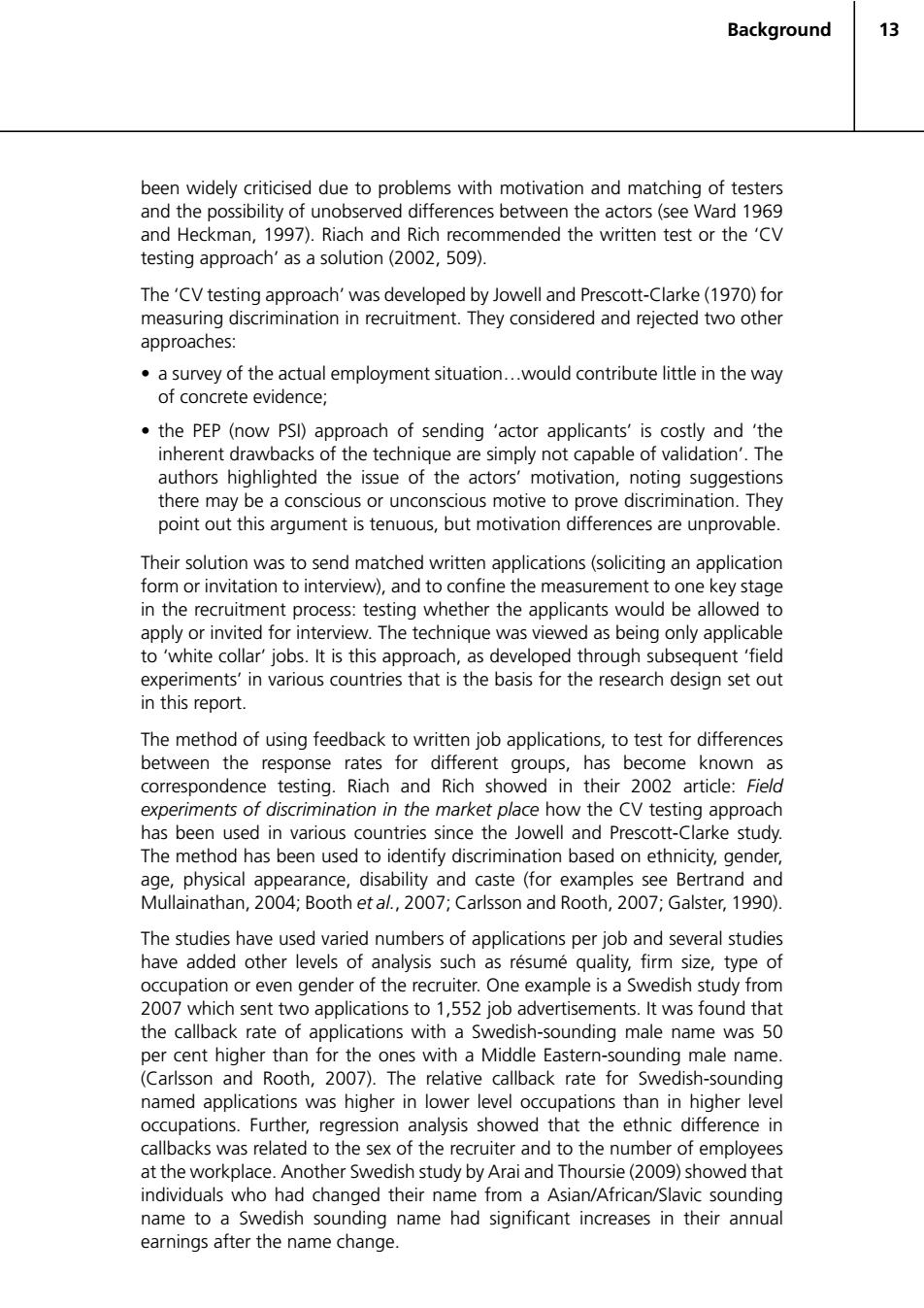正在加载图片...

Background 13 been widely criticised due to problems with motivation and matching of testers and the possibility of unobserved differences between the actors(see Ward 1969 and Heckman,1997).Riach and Rich recommended the written test or the 'CV testing approach'as a solution(2002,509). The'CV testing approach'was developed by Jowell and Prescott-Clarke(1970)for measuring discrimination in recruitment.They considered and rejected two other approaches: a survey of the actual employment situation...would contribute little in the way of concrete evidence; the PEP (now PSI)approach of sending 'actor applicants'is costly and 'the inherent drawbacks of the technique are simply not capable of validation'.The authors highlighted the issue of the actors'motivation,noting suggestions there may be a conscious or unconscious motive to prove discrimination.They point out this argument is tenuous,but motivation differences are unprovable. Their solution was to send matched written applications(soliciting an application form or invitation to interview),and to confine the measurement to one key stage in the recruitment process:testing whether the applicants would be allowed to apply or invited for interview.The technique was viewed as being only applicable to 'white collar'jobs.It is this approach,as developed through subsequent 'field experiments'in various countries that is the basis for the research design set out in this report. The method of using feedback to written job applications,to test for differences between the response rates for different groups,has become known as correspondence testing.Riach and Rich showed in their 2002 article:Field experiments of discrimination in the market place how the CV testing approach has been used in various countries since the Jowell and Prescott-Clarke study. The method has been used to identify discrimination based on ethnicity,gender, age,physical appearance,disability and caste (for examples see Bertrand and Mullainathan,2004;Booth et al.,2007;Carlsson and Rooth,2007;Galster,1990). The studies have used varied numbers of applications per job and several studies have added other levels of analysis such as resume quality,firm size,type of occupation or even gender of the recruiter.One example is a Swedish study from 2007 which sent two applications to 1,552 job advertisements.It was found that the callback rate of applications with a Swedish-sounding male name was 50 per cent higher than for the ones with a Middle Eastern-sounding male name. (Carlsson and Rooth,2007).The relative callback rate for Swedish-sounding named applications was higher in lower level occupations than in higher level occupations.Further,regression analysis showed that the ethnic difference in callbacks was related to the sex of the recruiter and to the number of employees at the workplace.Another Swedish study by Arai and Thoursie(2009)showed that individuals who had changed their name from a Asian/African/Slavic sounding name to a Swedish sounding name had significant increases in their annual earnings after the name change.13 been widely criticised due to problems with motivation and matching of testers and the possibility of unobserved differences between the actors (see Ward 1969 and Heckman, 1997). Riach and Rich recommended the written test or the ‘CV testing approach’ as a solution (2002, 509). The ‘CV testing approach’ was developed by Jowell and Prescott-Clarke (1970) for measuring discrimination in recruitment. They considered and rejected two other approaches: • a survey of the actual employment situation…would contribute little in the way of concrete evidence; • the PEP (now PSI) approach of sending ‘actor applicants’ is costly and ‘the inherent drawbacks of the technique are simply not capable of validation’. The authors highlighted the issue of the actors’ motivation, noting suggestions there may be a conscious or unconscious motive to prove discrimination. They point out this argument is tenuous, but motivation differences are unprovable. Their solution was to send matched written applications (soliciting an application form or invitation to interview), and to confine the measurement to one key stage in the recruitment process: testing whether the applicants would be allowed to apply or invited for interview. The technique was viewed as being only applicable to ‘white collar’ jobs. It is this approach, as developed through subsequent ‘field experiments’ in various countries that is the basis for the research design set out in this report. The method of using feedback to written job applications, to test for differences between the response rates for different groups, has become known as correspondence testing. Riach and Rich showed in their 2002 article: Field experiments of discrimination in the market place how the CV testing approach has been used in various countries since the Jowell and Prescott-Clarke study. The method has been used to identify discrimination based on ethnicity, gender, age, physical appearance, disability and caste (for examples see Bertrand and Mullainathan, 2004; Booth et al., 2007; Carlsson and Rooth, 2007; Galster, 1990). The studies have used varied numbers of applications per job and several studies have added other levels of analysis such as résumé quality, firm size, type of occupation or even gender of the recruiter. One example is a Swedish study from 2007 which sent two applications to 1,552 job advertisements. It was found that the callback rate of applications with a Swedish-sounding male name was 50 per cent higher than for the ones with a Middle Eastern-sounding male name. (Carlsson and Rooth, 2007). The relative callback rate for Swedish-sounding named applications was higher in lower level occupations than in higher level occupations. Further, regression analysis showed that the ethnic difference in callbacks was related to the sex of the recruiter and to the number of employees at the workplace. Another Swedish study by Arai and Thoursie (2009) showed that individuals who had changed their name from a Asian/African/Slavic sounding name to a Swedish sounding name had significant increases in their annual earnings after the name change. Background